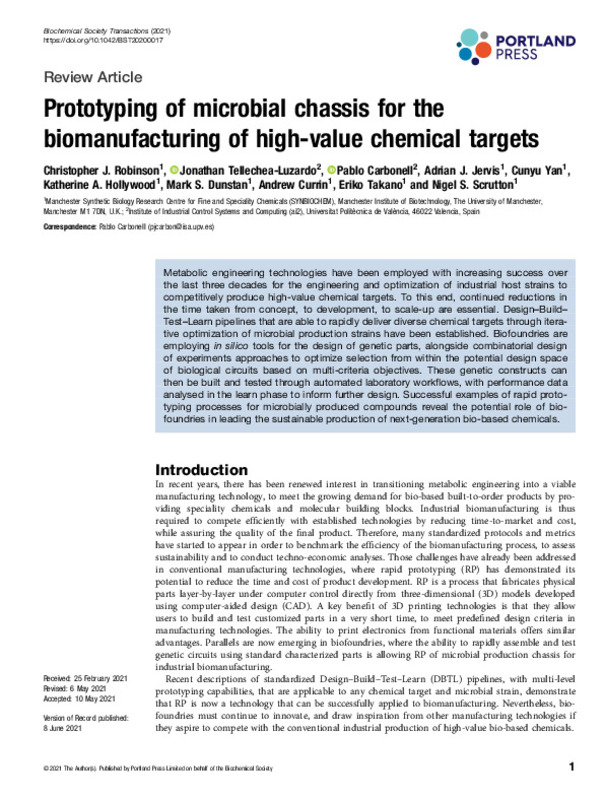JavaScript is disabled for your browser. Some features of this site may not work without it.
Buscar en RiuNet
Listar
Mi cuenta
Estadísticas
Ayuda RiuNet
Admin. UPV
Prototyping of microbial chassis for the biomanufacturing of high-value chemical targets
Mostrar el registro sencillo del ítem
Ficheros en el ítem
| dc.contributor.author | Robinson, Christopher J.
|
es_ES |
| dc.contributor.author | Tellechea-Luzardo, Jonathan
|
es_ES |
| dc.contributor.author | Carbonell, Pablo
|
es_ES |
| dc.contributor.author | Jervis, Adrian J.
|
es_ES |
| dc.contributor.author | Yan, Cunyu
|
es_ES |
| dc.contributor.author | Hollywood, Katherine A.
|
es_ES |
| dc.contributor.author | Dunstan, Mark S.
|
es_ES |
| dc.contributor.author | Currin, Andrew
|
es_ES |
| dc.contributor.author | Takano, Eriko
|
es_ES |
| dc.contributor.author | Scrutton, Nigel S.
|
es_ES |
| dc.date.accessioned | 2023-09-21T18:04:53Z | |
| dc.date.available | 2023-09-21T18:04:53Z | |
| dc.date.issued | 2021-06 | es_ES |
| dc.identifier.issn | 0300-5127 | es_ES |
| dc.identifier.uri | http://hdl.handle.net/10251/196899 | |
| dc.description.abstract | [EN] Metabolic engineering technologies have been employed with increasing success over the last three decades for the engineering and optimization of industrial host strains to competitively produce high-value chemical targets. To this end, continued reductions in the time taken from concept, to development, to scale-up are essential. Design-Build-Test-Learn pipelines that are able to rapidly deliver diverse chemical targets through iterative optimization of microbial production strains have been established. Biofoundries are employing in silico tools for the design of genetic parts, alongside combinatorial design of experiments approaches to optimize selection from within the potential design space of biological circuits based on multi-criteria objectives. These genetic constructs can then be built and tested through automated laboratory workflows, with performance data analysed in the learn phase to inform further design. Successful examples of rapid proto-typing processes for microbially produced compounds reveal the potential role of biofoundries in leading the sustainable production of next-generation bio-based chemicals. | es_ES |
| dc.description.sponsorship | This work was supported by the Biotechnology and Biological Sciences Research Council (BBSRC) and the Engineering and Physical Sciences Research Council (EPSRC) under grants: 'Center for synthetic biology of fine and speciality chemicals (SYNBIOCHEM)' (BB/M017702/1) and `Future Biomanufacturing Research Hub' (EP/S01778X/1). | es_ES |
| dc.language | Inglés | es_ES |
| dc.publisher | Portland Press | es_ES |
| dc.relation.ispartof | Biochemical Society Transactions | es_ES |
| dc.rights | Reserva de todos los derechos | es_ES |
| dc.subject.classification | INGENIERIA DE SISTEMAS Y AUTOMATICA | es_ES |
| dc.title | Prototyping of microbial chassis for the biomanufacturing of high-value chemical targets | es_ES |
| dc.type | Artículo | es_ES |
| dc.identifier.doi | 10.1042/BST20200017 | es_ES |
| dc.relation.projectID | info:eu-repo/grantAgreement/EPSRC//EP%2FS01778X%2F1/ | es_ES |
| dc.relation.projectID | info:eu-repo/grantAgreement/BBSRC//BB%2FM017702%2F1/ | es_ES |
| dc.rights.accessRights | Abierto | es_ES |
| dc.contributor.affiliation | Universitat Politècnica de València. Escuela Técnica Superior de Ingenieros Industriales - Escola Tècnica Superior d'Enginyers Industrials | es_ES |
| dc.description.bibliographicCitation | Robinson, CJ.; Tellechea-Luzardo, J.; Carbonell, P.; Jervis, AJ.; Yan, C.; Hollywood, KA.; Dunstan, MS.... (2021). Prototyping of microbial chassis for the biomanufacturing of high-value chemical targets. Biochemical Society Transactions. 49(3):1055-1063. https://doi.org/10.1042/BST20200017 | es_ES |
| dc.description.accrualMethod | S | es_ES |
| dc.relation.publisherversion | https://doi.org/10.1042/BST20200017 | es_ES |
| dc.description.upvformatpinicio | 1055 | es_ES |
| dc.description.upvformatpfin | 1063 | es_ES |
| dc.type.version | info:eu-repo/semantics/publishedVersion | es_ES |
| dc.description.volume | 49 | es_ES |
| dc.description.issue | 3 | es_ES |
| dc.identifier.pmid | 34100907 | es_ES |
| dc.relation.pasarela | S\439171 | es_ES |
| dc.contributor.funder | Engineering and Physical Sciences Research Council, Reino Unido | es_ES |
| dc.contributor.funder | Biotechnology and Biological Sciences Research Council, Reino Unido | es_ES |








